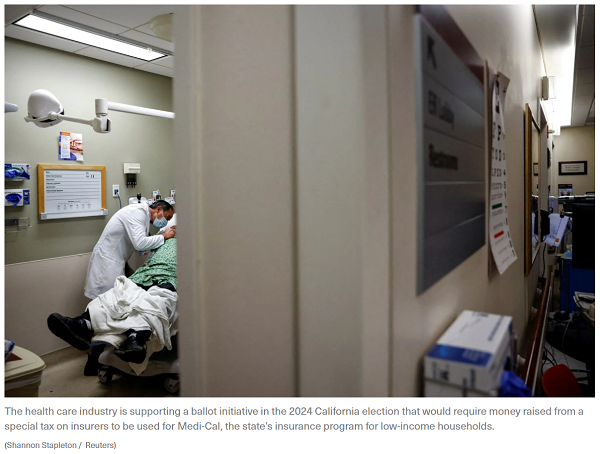California voters will decide who wins on health care tax: Gavin Newsom or doctors
By Kristen Hwang (CalMatters)
July 5, 2024
 A two-year cash influx or a long-term investment? Come November it will be up to California voters whether to lock billions of special tax dollars into Medi-Cal — the state’s health insurance program for low-income residents — or leave the decision up to lawmakers who might be tempted to use the money elsewhere.
A two-year cash influx or a long-term investment? Come November it will be up to California voters whether to lock billions of special tax dollars into Medi-Cal — the state’s health insurance program for low-income residents — or leave the decision up to lawmakers who might be tempted to use the money elsewhere.
The budget deal Gov. Gavin Newsom signed on Saturday commits roughly $2 billion through 2026 to increase payments to some doctors and health providers who see Medi-Cal patients, encouraging them to accept more low-income patients. The deal relies on a special tax that health insurance companies pay.
But there’s a catch in the upcoming election, and it could undo some payment increases that are in the budget. Low-income families with young children are among the people who could lose out.
A ballot initiative supported by nearly the entire health care industry seeks to hold Newsom to a promise made last year to permanently secure that tax money for health care rather than letting future lawmakers use it to offset cuts to prisons, parks, roads and other services.
They say Newsom backtracked on their agreement when he put forward budget plans earlier this year to address the state’s multibillion-dollar deficit. The tax is expected to generate more than $35 billion over the next four years. The budget Newsom signed puts most of that money in the state’s general spending account.
But if voters pass the ballot initiative in November, they would effectively undo that part of the deal. Under the initiative, Medi-Cal would get more money, and a different but bigger group of doctors and providers would get higher rate increases than what is currently in the budget.
The initiative’s main supporters, which include the California Medical Association and Planned Parenthood Affiliates of California, say voters should decide if they want to prevent future lawmakers from using money meant for Medi-Cal on other services.
“The best way to protect our Medi-Cal program and those vulnerable patients is to invest in it,” said Jodi Hicks, co-chair of the initiative coalition and president of Planned Parenthood Affiliates of California. “Every day that a patient can see a doctor is a good day, and we need to invest and ensure that’s happening for as long as we can.”
The money in question comes from a special tax known as the Managed Care Organization, or MCO tax: Health insurers agree to be taxed to get a dollar-for-dollar match from the federal government.
The tax is projected to generate more than $5 billion next year. California has relied on this tax for decades to offset state general fund spending on Medi-Cal, which some experts say is risky given signals from the federal government that it may stop providing matching funds to the state. Doctors have argued that the money — while it lasts — should be used to increase provider payments.
Expanded access to Medi-Cal
For the past decade, California lawmakers have steadily restored Medi-Cal services cut during the Great Recession, added new ones, and expanded eligibility to include all low-income Californians regardless of citizenship. Today, more than 15 million Californians — more than a third of its residents — are enrolled in Medi-Cal, but many doctors say eligibility and benefit expansions have come without commensurate rate increases. As a result, too few providers accept Medi-Cal patients.
Assemblymember Akilah Weber, an obstetrician from La Mesa, said California’s failure to increase rates makes it impossible to tackle long-standing health disparities among marginalized communities.
“It’s nice to give people insurance, but if they have no providers to go to, we haven’t done much,” Weber said.
Weber, a Democrat, has not endorsed the ballot initiative. But during recent Assembly budget hearings, she criticized Newsom representatives for…
[READ THE COMPLETE ARTICLE HERE]
